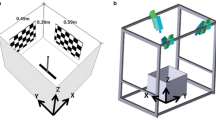Abstract
Lake Michigan mottled sculpin respond to a chemically-inert vibrating sphere (a dipole source) with an initial orientation towards the source followed by a step-wise progression towards and final strike at the source. An analysis of videotape recordings of this behavior indicate that although pathways to the source varied, they tended to be influenced by the fish's position at signal onset. Fish heading toward the source at signal onset approached the source in an indirect fashion by either (a) keeping the source to one side in a smoothly arching path to the source or (b) alternating between keeping the source to the left and to the right. When the source was to the side of the fish at the time of stimulus onset, fish tended to approach the source in a more direct path. Most (79%) initial orienting responses placed the fish within 45° of the source, but response angles were not strongly correlated with initial source angle. Most (83%) unsuccessful strikes (misses) occurred when the source was directly in front of the fish (± 20°) and source angles associated with misses were significantly smaller than source angles associated with successful strikes. Approach strategies used by mottled sculpin in finding dipole sources appear to include (1) moving in a direction that increases the pressure difference along the head while keeping it consistently low (between 1 and 10 Pa) across the head, (2) narrowing the fish-to-source gap with each successive step in the pathway, (3) keeping the source lateralized (on average, 30° to one or the other side of the head) and (4) avoiding approach positions that are perpendicular to the flow line or that place the fish in the pressure null area of the dipole field. These results are consistent with the hypothesis that spatial excitation patterns along the lateral line system play a major role in encoding both source direction and distance.
Similar content being viewed by others
Author information
Authors and Affiliations
Additional information
Accepted: 23 October 1996
Rights and permissions
About this article
Cite this article
Coombs, S., Conley, R. Dipole source localization by mottled sculpin. I. Approach strategies. J Comp Physiol A 180, 387–399 (1997). https://doi.org/10.1007/s003590050057
Issue Date:
DOI: https://doi.org/10.1007/s003590050057




